|
Hennepin County is immediately discontinuing battery collection at community locations, which include city and county buildings, libraries, schools, and community centers, due to concerns about fire hazards. Batteries will continue to be accepted at the county’s drop-off facilities in Bloomington and Brooklyn Park, and residents should use these options to properly dispose of button batteries, lithium ion batteries, rechargeable batteries, and electronic devices.
Fire hazard contributed to decision
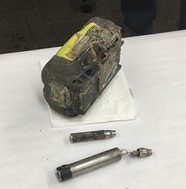
While the county strives to offer the most convenient recycling options for residents, it has been determined that the county can no longer collect these items in community locations.
The concern arose when vape pens/e-cig devices, which contain batteries that are difficult to remove, were found in battery recycling bins. The combination of vape pens/e-cig devices that heat up when activated and rechargeable batteries that are flammable is dangerous. The specific concern with vape pens is that many have a push button activator, which turns on the heat with very little pressure.
How to dispose of batteries
|
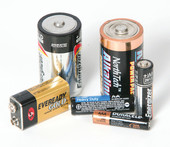 |
|
Alkaline batteries (single-use AA, AAA, etc.) do not contain hazardous materials and may be placed in the trash. The county also accepts alkaline batteries at the drop-off facilities for recycling. |
 |
|
Button batteries, Lithium ion batteries, and other rechargeable batteries contain toxic metals and pose a threat if improperly disposed. These batteries should not be placed in your trash or recycling at home. These batteries should be brought to a Hennepin County drop-off facility in Bloomington and Brooklyn Park or hazardous waste collection events. Call2Recycle.org lists additional drop-off sites at retail locations for rechargeable batteries. |
 |
|
For devices that have batteries that are difficult to remove, such as vape pens/e-cig devices, cell phones, laptops, and digital watches, the entire device should be brought to a Hennepin County drop-off facility. |
Storing batteries safely
To prevent fires, it is important to store batteries safely until they can be brought to a recycling site:
- Place batteries in a clear plastic bag OR place clear tape on both the positive (+) and negative (-) terminals of batteries.
- Bulging or damaged lithium ion batteries should be brought to a drop-off facility as soon as possible. They should not be placed in any recycling or trash container.
Read the Star Tribune article, watch the Kare11 story, and visit hennepin.us/batteryrecycling to learn more.
Grants to expand organics recycling programs awarded to 31 cities
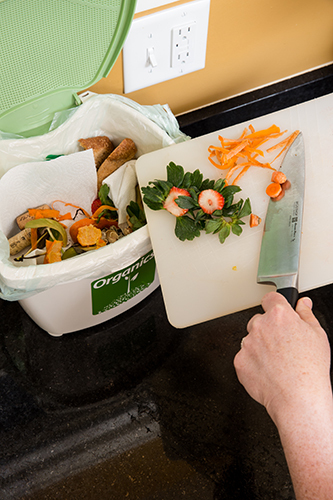
Hennepin County recently awarded grants totaling $1.4 million to 31 cities to support their organics recycling programs. Organics recycling involves collecting food scraps, non-recyclable paper and compostable products so that they can be composted into a nutrient-rich soil amendment.
Cities offer different ways to participate in organics recycling – through citywide programs, through specific haulers, and with drop-offs. All cities in the county are required to make organics recycling service available to households with curbside recycling service by 2022.
Currently, about 59,000 households, or 17 percent of households in the county, participate in city organics recycling programs. Recent developments in city organics recycling programs include Robbinsdale starting citywide collection in 2019, Richfield and Bloomington opening drop-off sites, and Edina planning to launch their program in 2020.
To increase participation, cities are using the funding to increase education, offset the cost of service, and provide supplies such as compostable bags and kitchen pails to participants.
This funding is a portion of what the county receives from the state’s Select Committee on Recycling and the Environment (SCORE), which the county distributes to support city recycling programs. Recognizing that organics recycling is the greatest opportunity to reduce our trash and that financial incentives are needed to make organics recycling more widely available, the county allocated 40 percent of SCORE funding to organics recycling in 2019 and will allocate 50 percent of SCORE funding to organics in 2020.
For more information, contact Ben Knudson at ben.knudson@hennepin.us or 612-596-1176.
|
Healthy Tree Canopy grants awarded to 14 cities
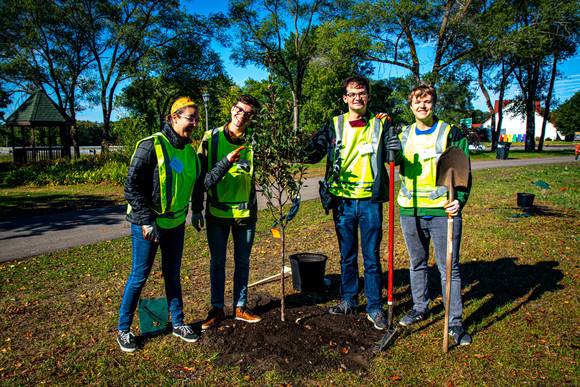
Healthy Tree Canopy grants totaling $237,000 were recently awarded to 14 cities to promote a more diverse, resilient, and equitable tree canopy. The grants will:
- Fund the collection of data through tree inventories.
- Mitigate the effects of tree pests and pathogens by increasing the capacity of city forestry programs, removing and replacing ash trees, and treating high quality ash trees.
- Educate residents on the benefits of trees and engage them in tree planting efforts.
- Improve livability by planting trees in neighborhoods that face economic, environmental, and health disparities.
Read about all of the grants awarded.
“It feels good to know you’ve contributed to protecting nature in perpetuity” - easement landowner
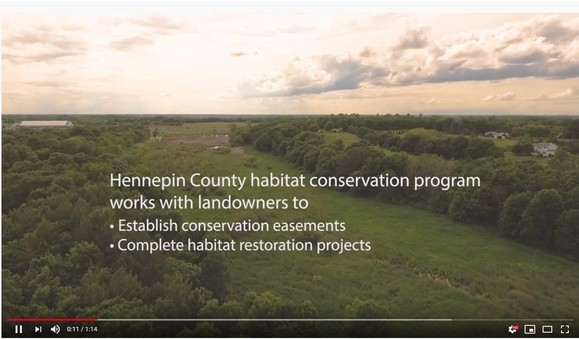
When a 13-acre conservation easement was established in Independence in 2018, it completed a habitat corridor connection between Lake Rebecca Regional Park and Lake Sarah. The corridor consists of six separate easements covering 38 acres established over the last 30 years.
The property was protected through the Hennepin County Habitat Conversation Program, which works with landowners to establish conservation easements on the best remaining natural areas in the county and conduct restoration projects on protected properties. A conservation easement is a set of development restrictions that a landowner voluntarily places on their property to permanently protect its natural resources. Conservation easements are one of the most effective tools for permanently protecting natural areas on private property.
This summer, 1,200 trees were planted on 3.5 acres of former farm field on the easement. The reforestation will help reduce greenhouse gas emissions by sequestering an estimated 3,600 tons of carbon dioxide over the next 25 years and improve water quality by infiltrating nearly 2.5 million gallons of rainfall annually.
Watch a time lapse of the reforestation and learn more about permanently protecting natural areas.
For more information, contact Kristine Maurer at kristine.maurer@hennepin.us or 612-348-6570.

Kimberley Carpenter became a Master Water Steward so that she could empower others in her community in Brooklyn Park to take action to protect water.
Master Water Stewards are community leaders who attend classes and complete a capstone project to become certified to educate the public about preventing water pollution. The capstone projects both benefit local waterways and incorporate community education. Hennepin County sponsors a cohort of Master Water Stewards every year.
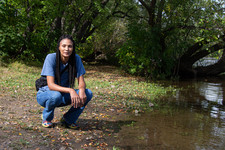
Kimberley’s capstone project focused on improving River Park in Brooklyn Park and raising awareness about protecting the Mississippi River through a series of collaborative partnerships. She worked with Hennepin County to assess the health of the wetland in river park, then partnered with a youth football team to remove invasive species that were encroaching on the wetland. To raise public awareness, she adopted storm drains near the park and worked with a team of artists and youth to create drain murals.
Learn more about her project and the Master Water Steward program on Clean Water Minnesota.
|
Green Gifts Fair

Saturday, November 23 from 10 a.m. to 5 p.m. at the Midtown Global Market, 920 East Lake Street in Minneapolis
Shop over 80 vendors for upcycled, recycled, fair-trade, and locally made gifts. Complete an activity passport throughout the fair for adult and kid-friendly prizes. Visit the Hennepin County Environment and Energy to learn about low-waste parties. Celebrate your green community through art, music, and more.
See a list of vendors, demos, and the main stage schedule.
|
Visit Recyclo and learn the value of recycling at the Washburn Library
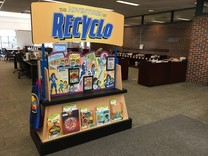
Recyclo, our superhero who teaches youth about the power of recycling all while fending off villains like the evil Lord Waste-A-Ton, is now at Washburn Library in south Minneapolis.
The display explores that value of recycling and how the glass, paper, metal, and plastics that you put in the recycling bin can be transformed into new products to be used again and again. The display has interactive elements for both pre-readers and learners in upper elementary grades, and kids can pick up their own copy of the Recyclo activity book (PDF). Visit Recyclo at the Washburn Library through November 25.
|
Natural resources partnership: Lawns to Legumes train-the-trainer workshop

Friday, November 8 from 1 to 3 p.m. at the Maple Grove Library in the Main Street Room
The next Hennepin County natural resources partnership forum will feature a train-the-trainer workshop about Lawns to Legumes, a new residential grant program from the Minnesota Board of Water and Soil Resources.
The program focuses on protecting a diversity of pollinator species by planting residential lawns with native vegetation and pollinator-friendly forbs and legumes. This train-the-trainer session will review the different types of projects eligible for cost share funding, including pollinator patches, prairie meadows, pollinator lawns, and native plants that are beneficial to the Rusty Patched Bumble Bee.
RSVPs are encouraged to Stacey Lijewski at stacey.lijewski@hennepin.us or 612-348-9938.
|
Planting different and unique trees helps to increase the diversity and resiliency of the county’s tree canopy and address the threat of emerald ash borer and other tree pests. The recent planting of more than 60 trees along New Brighton Boulevard and in Trillium Park in St. Anthony by Hennepin County foresters and community volunteers is a perfect example of these efforts.
Some of the trees were planted to replace ash trees that have been proactively removed before they become infested with emerald ash borer. Others were planted to add trees to a currently barren stretch of roadway.
Before the planting, the road corridor had about 70 trees of 8 different species. After the planting, the roadway has 117 trees of 22 different species!
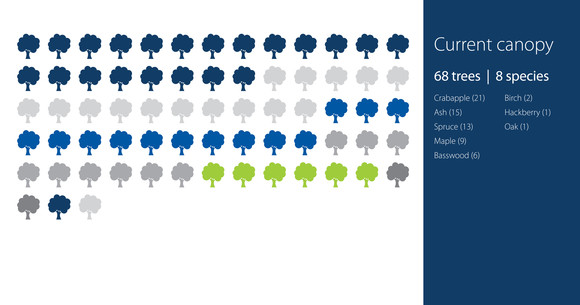 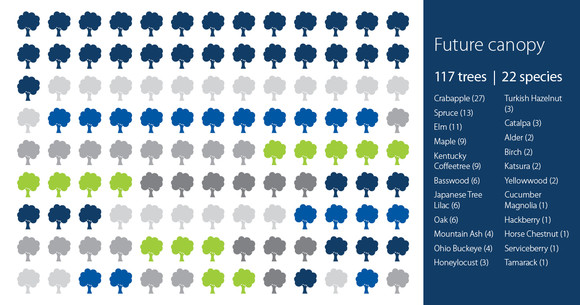
Unique tree species being planted
If you’re planting trees on your property, inventory the trees that you have and strive to plant different species to help support a more diverse and resilient urban forest. Be sure to also consider tree size and growing conditions to ensure you plant the right tree for your conditions.
For inspiration, here are some fun facts about unique trees that were planted in St. Anthony.
Princeton Elm
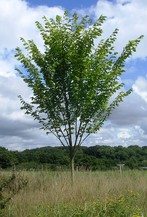 |
|
A true American Elm – not a hybrid – that has proven resistant to Dutch Elm Disease and Elm Leaf Beetle. This fast-growing, vase-shaped tree can reach 60 to 80 feet tall. |
Kentucky Coffeetree
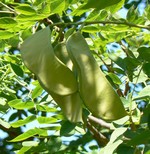 |
|
Despite its name, this tree is native to Minnesota. Nowadays, Kentucky Coffeetree is rare because its seed pods are too difficult for animals to chew through. It is believed that now-extinct megafauna such as mammoths and mastodons spread the seeds by eating the seed pods. Today, we have to collect and process the seeds before planting them. |
Cucumber Magnolia
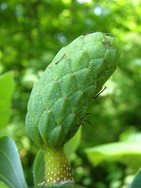 |
|
One of the cold-hardiest magnolia trees that is native to the eastern United States. The tree gets its name from its fruit, which when unripe is green and resembles a small cucumber. Photo credit: Michael Parker |
Catalpa
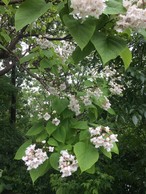 |
|
A peculiar ornamental shade tree with three distinct features that provide visual interest year-round. The Catalpa has large, heart-shaped leaves that can grow up to 12 inches long; clusters of large, trumpet shaped white flowers; and long bean pods that hang down from its branches. |
Oakleaf Mountain Ash
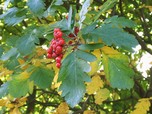 |
|
Despite its name, this tree is neither an oak nor an ash. Instead, it’s a hybrid species native to Scandinavia. Oakleaf Mountain Ash provides visual interest year-round with white flowers in the spring and attractive orange fruit later in the year. Photo credit: MPF on Wikimedia Commons |
|






















